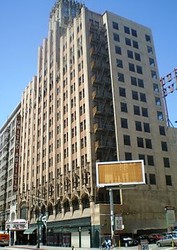The United Theatre on Broadway (United Artists Theatre Building)
Introduction
Text-to-speech Audio
The United Artists Theatre in Los Angeles opened on December 26, 1927, in conjunction with United Artists theatres in Detroit and Chicago, the first step in the film studio's theatre-chain operations; the theatre chain grew to become the nation's largest. Early movie stars, such as Charlie Chaplin, financed this theater, which was the chain's flagship, and occupied the ground floor of a thirteen-story office building occupied mainly by Texaco. The historic Spanish Gothic theatre and office building stood as the city's tallest for one year after its completion in 1927 and was the tallest privately owned structure in Los Angeles until 1956.
Images
2008 photo of the theatre and office building, then known as Ace Hotel

View of the historic

View of the historic theatre now known as The UNITED Theatre on Broadway

Foyer near the Ladies' Restroom demonstrates the ornate details that went into designing the grand theatre in the 1920s

Restored ceiling of the United Artists Theatre, now operating as The UNITED Theatre on Brodway

1950s photo of United Artists Theatre with the Texaco sign visible (Texaco occupied the office building for decades)

1931 photo of United Artists Theatre

Backstory and Context
Text-to-speech Audio
The United Artists Theatre in Los Angeles opened on December 26, 1927, in conjunction with United Artists theatres in Detroit and Chicago, heralding the movie studio's entrance into the world of theatre operations; the theatre chain grew to become the nation's largest. The Theatre in L.A. (the flagship) occupied the ground floor of a thirteen-story office building occupied mainly by Texaco, which signed a long-term lease. United Artists owned and operated the theatre until the middle of the twentieth century, before it changed ownership and function several times, even operating as a church for several decades. Today, nearly a century after Charlie Chaplin and fellow United Artists stars opened the theatre, it again enjoys the beauty of a grand palace as The United Theatre on Broadway.
This theater is located within the historic Broadway Theater and Commercial District, a multi-block thoroughfare consisting of numerous historic commercial buildings built in Los Angeles from the early 1890s to the early part of the 1930s Great Depression. When the United Artists Theatre opened in 1927, Broadway supported a considerable number of shops, hotels, restaurants, and theatres. Over time, Broadway district theatres grew larger and more extravagant despite a shift in the city's theater and movie industry district to Hollywood.
The historic United Theatre opened as one of more than 3,000 grand theatres built nationwide between 1925 and 1929. The theatre palaces enjoyed lavish designs and offered plenty of perks, which ostensibly symbolized the good feelings and rising consumerism associated with the thriving economic climate of the "Roaring '20s." United Theatre opened on December 26, 1927, built by the United Artists founders and movie stars such as Charlie Chaplin, D.W. Griffith, Douglas Fairbanks, and Mary Pickford. The entertainers intended to showcase the world premieres of their movies at the new theatre place.
The thirteen-story office building enjoys a Spanish-Gothic style design. Meanwhile, the interior of the United Theatre originally consisted of a lobby with a ceiling painted to imitate stained glass, a foyer with a vaulted ceiling and design inspired by an old Spanish cathedral, a theatre with seating for 2,214 patrons, and a host of ornamental elements, murals, fine lighting, plush furniture, and other lavish features.
Unlike the majority of 1920s grand movie palaces that struggled after World War II, the historic United Artists Theatre enjoyed success into the mid-twentieth century. In the 1950s, United Artists upgraded with modern, wide-screen viewing capabilities, including installing a giant curved screen. However, by the 1970s and 1980s, United Artists sold the theatre to Metropolitan Theatres, who eventually closed as a full-time cinema in the summer of 1989.
Dr. Eugene Scott purchased the theatre in 1989 and transitioned it into the home of the Los Angeles University Cathedral. Scott died in 2005, but the church remained in operation until 2010. The church sold the property to a developer in the fall of 2011, who converted the office building into the Ace Hotel, which opened in January 2014. One month later, the theatre portion of the property again served as an entertainment space, hosting concerts; the historic theatre became known as "Theatre at the Ace Hotel." Most recently, the Ace Hotel closed in January 2024 but reopened shortly thereafter as "The UNITED Theater on Broadway."
Cite This Entry
Powers, Mathew and Clio Admin. "The United Theatre on Broadway (United Artists Theatre Building)." Clio: Your Guide to History. May 7, 2025. Accessed August 14, 2025. https://theclio.com/entry/42555
Sources
Eschner, Kat. "Movie Palaces Let Everyday Americans Be Royalty." Smithsonian Magazine. smithsonianmag.com. April 12, 2017. https://www.smithsonianmag.com/smart-news/movie-palaces-let-everyday-americans-be-royalty-180962824.
O'Connor, Pauline. 'Inside the New Ace Hotel's Dazzling Old United Artists Theatre." LA Curbed. February 06, 2014. https://la.curbed.com/2014/2/6/10147196/inside-the-new-ace-hotels-dazzling-old-united-artists-theatre.
Sitton, Tom. "Nomination Form: Broadway Theatre and Commercial District." National Register of Historic Places. nps.gov. 1979. https://npgallery.nps.gov/GetAsset/d41bca98-3f44-45c2-b049-ad3bce5f4c01/.
Slowinska, Maria A. "Consuming Illusion, Illusions of Consumability: American Movie Palaces of the 1920s." American Studies 50, no. 4 (2005): 575-601.
"UNITED Theater on Broadway." Cinema Treasures. Accessed April 21, 2025. http://cinematreasures.org/theaters/489.
By Los Angeles - Own work, CC BY-SA 3.0, https://commons.wikimedia.org/w/index.php?curid=4323943
https://theunitedtheater.com/
https://theunitedtheater.com/
https://theunitedtheater.com/
Los Angeles Historic Theatre Foundation: https://www.lahtf.org/theaters/unitedartists/
Cinema Treasures: https://cinematreasures.org/theaters/489
Cinema Treasures: https://cinematreasures.org/theaters/489

